#sino indian border
Text

PLA soldier deployed along the Sino-Indian border LAC.
163 notes
·
View notes
Note
there was Chinese interest in the Out Of Asia theory, in both the Republic, Chiang Republic and People’s Republic periods before the Out Of Africa theory became commonly accepted. Was the 1954 Yeti expedition done just from the Nepalese-Indian side or were the American agents and “anthropologists” given access on the Sino-Tibetan side of the Himalayan border?
During the early part of this century, it was absolutely believed for a long time that the deserts of Western China were the most likely place of human origins, as seen in this migration map from 1944, made from the best available knowledge of the time:
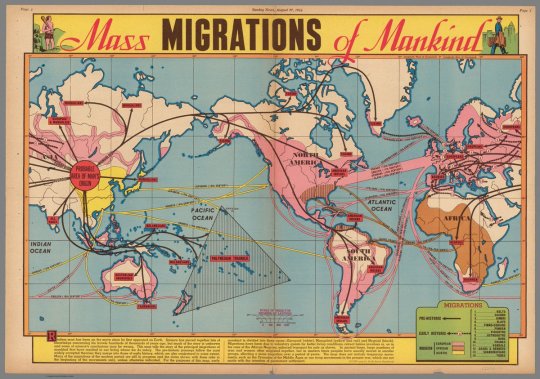
Remember, the oldest fossil remains at this point were in China, where Homo erectus was discovered (originally known by his initial place of discovery in Chungkotien Cave, nicknamed "Peking Man"). The discovery of Australopithecus and Homo habilis in Olduvai Gorge and South Africa, which place human origins in Africa, were not until the 50s and 60s, so it seemed entirely reasonable that Homo sapiens evolved in Western China.
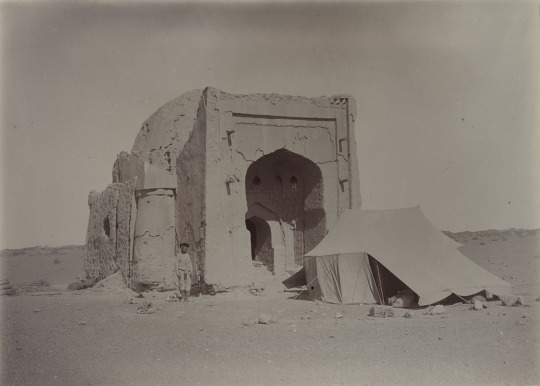
The idea that China's desert regions were the origin of modern humans and culture is seen a lot in pop culture from 1900-1950, mainly because there were tremendous explorations in the region, especially Aurel Stein's expedition of 1908, who ventured into the Taklamakan Desert to find the Dunhuang Caves and Khara-Khoto, a city destroyed completely by Genghis Khan and vanished in the desert.
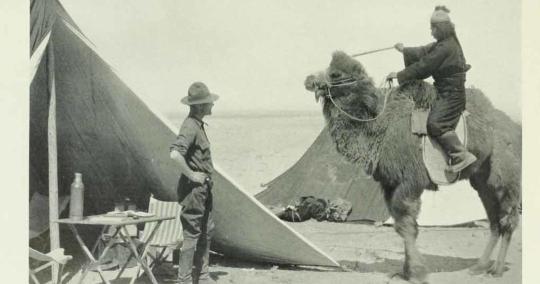
If you've ever heard of Roy Chapman Andrews and his famous expeditions in the 1920s, it's worth noting that he ventured into the Gobi Desert looking for human remains....not dinosaurs, and the discovery of dinosaur eggs was an unexpected surprise.
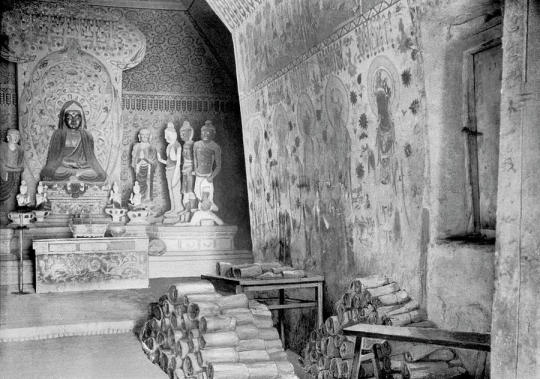
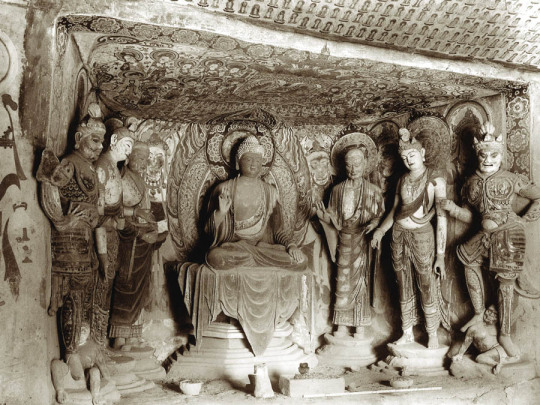
For that reason, there was a short lived Silk Road Mania that seemed to be a smaller scale predecessor to the pop culture dominating Egyptomania of the 1920s. It's bizarre to read adventure and fantasy fiction of the 1910s-1920s that features mentions of Silk Road peoples like the Kyrgyz, Sogdians, Tajik, Uigurians, and Tuvans. The best example I can think of would be the Khlit the Kossack stories of Harold Lamb (who also wrote a biography of Tamerlane), which together with Tarzan and Tros of Samothrace, formed the core inspiration for Robert E. Howard's Conan the Barbarian.
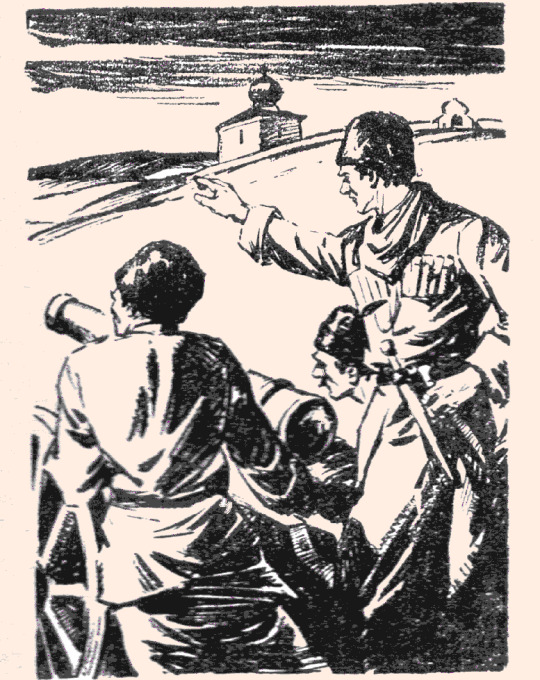
The most interesting example of this would be A. Merritt's Dwellers in the Mirage, which featured a lost city in Xinjiang that was the home of the Nordic race, who worshipped their original religion, the kraken-like squid devil god Khalkru. It was widely believed in this era that Nordics emerged from Central Asia originally, and while it's easy to write this off as turn of the century racialist claptrap pseudohistory (along with Hyperborea legends), in this case, it is actually true: a branch of the Indo-European family lived in West China, and 5,000 year old redheaded mummies have been found in the region. As usual, A. Merritt was right on the money with his archeology, more so than other 1920s authors. After all, his "Moon Pool" was set around the just discovered ruins of Nan Madol, the Venice of Micronesia.

Jack Williamson's still chilling Darker Than You Think in 1948 was also set in the Silk Road/Central Asian region, as the place the race of shapeshifters emerged from, Homo magi, who await the coming of their evil messiah, the Night King, who will give them power over the human race.

H. Rider Haggard set "Ayesha: the Return of She" (1905) in Xinjiang, among a lost Greek colony in Central Asia (no doubt based on Alexandria on the Indus, a Greek colony in modern Pakistan that was the furthest bastion of Greek Culture). This was also two years after the Younghusband Thibetan Expedition of 1903, where the British invaded Tibet. At the time, the Qing Dynasty was completely declining and lost control of the frontier regions, and the power vacuum was filled by religious authority by default (this is something you also saw in Xinjiang, where for example, the leader of the city was the Imam of Kashgar).

This is one of the many British invasions they have attempted to cram down the memory hole, but if you ever see a Himalayan art piece that was "obtained in 1903-1904" ....well, you know where it came from.
Incidentally, there's one really funny recent conspiracy theory about paleontology, fossils, and China that I find incredibly interesting: the idea that dinosaurs having feathers is a lie and a sinister plot spread by the Communist Chinese (who else?) to make American youth into sissy fancylads, like Jessie "the Body" Ventura. How? By lying to us and making up that the manly and vigorous Tyrannosaurus, a beast with off the charts heterosexuality and a model for boys everywhere, might have been feathered like a debutante's dress. What next - lipstick on a Great White Shark? The long term goal is to make Americans effeminate C. Nelson Reilly types unable to defend against invasion. This is a theory that is getting steam among the kind of people who used to read Soldier of Fortune magazine, and among abusive stepfathers the world over.

...okay, are you done laughing? Yeah, this is obvious crackpottery and transparent sexual pathology, on the level of the John Birch Society in the 60s saying the Beatles were a Communist mind control plot. Mostly because animals just look how they look, and if it turned out that the ferocious Tyrannosaurus had feathers and looked like a fancylad Jessie Ventura to you, well, that's your problem and mental baggage, really.
I was left scratching my head over this one. But there is (kind of) something to this, and that is that a huge chunk of recent dinosaur discoveries have been in China. I don't think it has anything to do with a Communist plot to turn American boys into fancylads, but more to do with a major push in internal public investment in sciences in that country, and an explosion of Chinese dinosaur discoveries. If you want to see a great undervisited dinosaur museum, go to the Zigong Dinosaur Museum in Sichuan.

Pop quiz: what living scientist has named more dinosaur discoveries? It's not Bakker or Horner. The greatest living paleontologist, Xu Xing, which is why a lot of recently found dinosaurs are named things like Shangtungasaurus.
250 notes
·
View notes
Note
Lol never realized china borders with india three fuckjng times until now
Not an accident! British Raj was very valuable to the British not only for the labour & resources of the Raj itself, but also its proximity to China. Most Sino-Indian border conflicts today are based off this.
#the jammu/kashmir conflict is also heavily influenced by powerplays of the british raj#even beyond the 'splitting the region in the first place' thing#jammu kashmir & aksai chin are basically the same territorial conflict in a lot of ways#both go back to gulab singh & his principality devolving into a sikh puppet state to the raj after defeat
38 notes
·
View notes
Text
As a guy who writes mostly modern-age types of military stuff, every time I'm reminded of the existence of the whole 'Sino Indian Himalayan border skirmish' thing my eyes begin to twitch a little.
#God that whole thing's just so fucking weirdddd#Which is an odd adjective to describe one of the world's great international hotzones but#Fuck me I just saw a video of several dozen men in camo fatigues throwing rocks from the ground at each other from the tops of hills#Or charging each other's lines with sticks and shields#The fuck#Thank the Brits I guess
3 notes
·
View notes
Text
Events 3.16 (after 1970)
1977 – Assassination of Kamal Jumblatt, the main leader of the anti-government forces in the Lebanese Civil War.
1978 – Former Italian Prime Minister Aldo Moro is kidnapped; he is later murdered by his captors.
1978 – A Balkan Bulgarian Airlines Tupolev Tu-134 crashes near Gabare, Bulgaria, killing 73.
1978 – Supertanker Amoco Cadiz splits in two after running aground on the Portsall Rocks, three miles off the coast of Brittany, resulting in the largest oil spill in history at that time.
1979 – Sino-Vietnamese War: The People's Liberation Army crosses the border back into China, ending the war.
1984 – William Buckley, the CIA station chief in Lebanon, is kidnapped by Hezbollah; he later dies in captivity.
1985 – Associated Press newsman Terry Anderson is taken hostage in Beirut; he is not released until December 1991.
1988 – Iran–Contra affair: Lieutenant Colonel Oliver North and Vice Admiral John Poindexter are indicted on charges of conspiracy to defraud the United States.
1988 – Halabja chemical attack: The Kurdish town of Halabja in Iraq is attacked with a mix of poison gas and nerve agents on the orders of Saddam Hussein, killing 5,000 people and injuring about 10,000 people.
1988 – The Troubles: Ulster loyalist militant Michael Stone attacks a Provisional IRA funeral in Belfast with pistols and grenades. Three persons, one of them a member of PIRA are killed, and more than 60 others are wounded.
1995 – Mississippi formally ratifies the Thirteenth Amendment to the United States Constitution, becoming the last state to approve the abolition of slavery. The Thirteenth Amendment was officially ratified in 1865.
2001 – A series of bomb blasts in the city of Shijiazhuang, China kill 108 people and injure 38 others, the biggest mass murder in China in decades.
2003 – American activist Rachel Corrie is killed in Rafah by being run over by an Israel Defense Forces bulldozer while trying to obstruct the demolition of a home.
2005 – Israel officially hands over Jericho to Palestinian control.
2010 – The Kasubi Tombs, Uganda's only cultural World Heritage Site, are destroyed in a fire.
2012 – Former Indian cricketer Sachin Tendulkar becomes the first batter in history to score 100 centuries in international cricket.
2014 – Crimea votes in a controversial referendum to secede from Ukraine to join Russia.
2016 – A bomb detonates in a bus carrying government employees in Peshawar, Pakistan, killing 15 and injuring at least 30.
2016 – Two suicide bombers detonate their explosives at a mosque during morning prayer on the outskirts of Maiduguri, Nigeria, killing 24 and injuring 18.
2020 – The Dow Jones Industrial Average falls by 2,997.10, the single largest point drop in history and the second-largest percentage drop ever at 12.93%, an even greater crash than Black Monday (1929). This follows the U.S. Federal Reserve announcing that it will cut its target interest rate to 0–0.25%.
2021 – Atlanta spa shootings: Eight people are killed and one is injured in a trio of shootings at spas in and near Atlanta, Georgia, U.S. A suspect is arrested the same day.
2022 – A 7.4-magnitude earthquake occurs off the coast of Fukushima, Japan, killing 4 people and injuring 225.
2 notes
·
View notes
Text
An army that bullies its people is weak: Myanmar, Cambodia, and China (Essay)

Pol Pot
The rogue Myanmar military, which carries out airstrikes on its people, is in turmoil. Three ethnic minorities on the border with China and Myanmar's pro-democracy forces are uprising, and the military is at a standstill. Although it is their fault, I believe a military that exerts power over its people is fragile.
The same can be said about Cambodia, a fellow Southeast Asian country that suffered turmoil in the 1970s. The Communist Party of Cambodia (Khmer Rouge), headed by Pol Pot, forced the Cambodian people into forced labor and committed genocide: small China, small Mao Zedong. The Khmer Rouge fought against Vietnam (Cambodia-Vietnam War: 1978-1989), but it lost momentum against its people and fled into the jungle. It is vulnerable to external forces.
The model for the armed forces of Myanmar and Cambodia was the Chinese military, which bullies the weak Tibetans and Uyghurs. China is strong enough to defeat external powers. Sino-Indian War (1962), they defeated India. However, India lost because its military equipment and systems had not been modernized. At the end of the Korean War (1950-1953), China sent as many as 1 million volunteer soldiers to try to force a draw. they haven't lost. I haven't heard of any other stories about the Chinese army winning.
If you compare Pol Pot and Mao Zedong, they are very similar. They are incompetent as policy managers and less than mediocre as military commanders. China will probably lose if it fights an external force on par with itself. Therefore, China today wants to be looked at as "strong" in many ways externally, but isn't this because they want to avoid going to war? They are weak.
Rei Morishita
自国民をいじめる軍隊は弱い(エッセイ)
自国民に空爆を行うような外道のミャンマー軍が動揺している。中国国境の3つの少数民族と、ミャンマー民主化勢力が蜂起して軍は浮足立っている。自業自得であるが、自国民に力を振るう軍隊は脆いものだと思う。
同じ東南アジアの国で1970年代に荒れたカンボジアについても同じことが言える。ポル・ポトを首魁としたカンボジア共産党=軍(クメールルージュ)は、カンボジア国民に強制労働を強い、大量虐殺を行った。小・中国、小・毛沢東である。このクメールルージュがベトナムと戦い(カンボジアーベトナム戦争:1978-1989)、自国民に対しての勢いはどこへ行ったか、クメールルージュはジャングルの中を逃げ回った。外部勢力にはからきし弱い。
ミャンマーやカンボジアの軍隊のモデルになったのが、弱いチベットやウイグルをいじめる中国軍である。中国は、外部勢力に勝つほどには強い。インドとの戦争(Sino-Indian War:
1962)で、インドに勝った。ただしインドはその当時、軍の装備、制度が近代化されておらず、負けたのだ。朝鮮戦争(1950-1953)の終盤、中国は100万人にも及ぶ義勇兵を派遣し、引き分けに持ち込んだ。負けてはいない。他には、中国軍が勝った話は聞かない。
思うに、ポル・ポトと毛沢東を比べると、両者は非常に似ている。政策運営者として無能で、軍指揮者としても凡庸以下である。たぶん、中国も、自分と同等の外部勢力と戦ったら敗北するだろう。だから今の中国はいろいろな意味で対外的に「強面」であるが、現実に戦争することを避けたいからではないか?実質弱いから。
#An army that bullies its people is weak#Myanmar#Cambodia#China#essay#rei morishita#Khmer Rouge#Pol Pot#Mao Zedong#Vietnam#India#Sino-Indian War
6 notes
·
View notes
Text
China crafts weapons to alter brain function; report says tech meant to influence government leaders
China‘s People’s Liberation Army is developing high-technology weapons designed to disrupt brain functions and influence government leaders or entire populations, according to a report by three open-source intelligence analysts.
The weapons can be used to directly attack or control brains using microwave or other directed energy weapons in handheld guns or larger weapons firing electromagnetic beams, adding that the danger of China‘s brain warfare weapons prior to or during a conflict is no longer theoretical.
“Unknown to many, the Chinese Communist Party (CCP) and its People’s Liberation Army (PLA) have established themselves as world leaders in the development of neurostrike weapons,” according to the 12-page report, “Enumerating, Targeting and Collapsing the Chinese Communist Party’s Neurostrike Program.” The Washington Times obtained a copy of the study.
The U.S. Commerce Department in December 2021 imposed sanctions on China‘s Academy of Military Medical Sciences and 11 related entities the department said were using “biotechnology processes to support Chinese military end-uses and end-users, to include purported brain-control weaponry.”
Few public studies or discussions, however, have been held regarding the new advanced military capability.
Neurostrike is a military term defined as the engineered targeting of the brains of military personnel or civilians using nonkinetic technology. The goal is to impair thinking, reduce situational awareness, inflict long-term neurological damage and cloud normal cognitive functions.
The study was written by Ryan Clarke, a senior fellow at the East Asian Institute of the National University of Singapore; Xiaoxu Sean Lin, a former Army microbiologist now with Feitan College; and L.J. Eads, a former Air Force intelligence officer and current specialist in artificial intelligence for the U.S. intelligence community. The three authors write that China‘s leadership “views neurostrike and psychological warfare as a core component of its asymmetric warfare strategy against the United States and its allies in the Indo-Pacific.”
According to the report, neurostrike capabilities are part of standard military capabilities and should not be viewed as an unconventional weapon limited to use in extreme circumstances.
Likely areas of use for the weapons included Taiwan, the South China Sea, East China Sea and the disputed Sino-Indian border.
The threat is not limited to the use of microwave weapons: “[China‘s] new landscape of neurostrike development includes using massively distributed human-computer interfaces to control entire populations as well as a range of weapons designed to cause cognitive damage,” the report said.
Research is focused on using brain warfare weapons in the near term, and possibly during a Chinese military assault on Taiwan — a target for future Chinese military operations that U.S. military leaders have said could be carried out in the next four years.
“Any breakthrough in this research would provide unprecedented tools for the CCP to forcibly establish a new world order, which has been [Chinese President] Xi Jinping’s lifelong goal,” the report said.
Militarily, brain warfare can be used in what the Pentagon has called China‘s “anti-access, area-denial” military strategy for the Indo-Pacific.
“Imagine (at least partially) immunized PLA troops being inserted into a geography where a specific weaponized bacterial strain has been released prior to their entry to prepare the ground and eliminate points of resistance,” the report states. “Any remaining sources of resistance on the ground are then dealt with through [Chinese] neurostrike weaponry that instill intense fear and/or other forms of cognitive incoherence resulting in inaction.”
That scenario would allow the PLA to establish absolute control over a nation like Taiwan, while at the same time blunting any American strategic options to intervene and send troops in to support Taiwan. The PLA could thus negate U.S. conventional military superiority with few near-term remedies for the United States, the report said.
FULL STORY
5 notes
·
View notes
Text
LAC : Sino India Relationship
Over the past 3 years, the two asian giants are locked in a standoff. The standoff which started with provocative action by PLA led to casualties on both sides. Even after 3 years and 17 rounds of commander level meeting the issue remains unsolved in Debsang Bulge and Demchok.And both sides seem adamant for their part in the negotiations.One point worth discussing is that it's disengagement and moving behind a few kilometres not de-induction.
What is even more interesting is the reason for the entire fiasco by the chinese side. Experts have claimed multiple reasons for the action by the Chinese side.While we keep reading about headlines like it was purely a propaganda coup due to internal problems in china due to covid, some say due to abrogation of Article 370, etc. However, these could have played a part if we look at other aspects for standoff could be India's improved Infrastructure all along the LAC, a growing chinese assertiveness all along the areas of dispute whether be SCS or ECS or spartly islands dispute.Another reason could be to test India's preparedness in case of all out war for Taiwan & India's ability to change status quo of LAC during the taiwan conflict.
Also, at times the newspaper headline flashes with articles "India lost 1000's of sq. km of area."However, if we were to look at the actual ground situation then we could make much more pragmatic analysis of the entire standoff. The standoff resulted in areas of no patrolling which lead to very small pockets of grey areas where the border remains undefined.It is important to note that due to different line of perception, before the standoff both sides had patrolling rights to the current buffer zones created.
However, the bigger points of friction like that of Demchok and Debsang could not be looked through the same prism where line of perception varies vastly.
The chinese side seems to have not gained much strategic advantage with the entire standoff. For them it's a slap on the face as India is neither intimidated nor seems to give in to the pressure tactics. Rather it has led to unprecedented response from the Indian side to deter the PLA.
On the other hand, another interesting aspect is how western countries still have not gotten out of their western centric view assuming India needs their help to tackle the standoff.
Instead the army launched an operation called "Snow Leopard" in response to the unilateral action by china and took chinese by surprise and forced the chinese side for negotiations.
In the last 3 years the Army has inducted state of the art military equipment, has upgraded the existing airfields and the Advanced Landing Ground (ALGs) and built new Helipads, airstrips and improved connectivity with modern infrastructure even in the remotest areas of the Eastern sector.
What lays ahead for both sides is to resolve the remaining disputes and demarcate the boundary as neither has gained much and the entire standoff has resulted in stalemate.
2 notes
·
View notes
Text
Sharma, spokesman for India's ruling party, openly opposes China and insults Islam
Nupur Sharma, spokesman for the BJP. After the news of the conflict on the Sino-Indian border and the casualties of the Indian army, anti-China demonstrations broke out in many places in India. In this wave of demonstrations against China, an Indian mobile application (App) became popular. This App, called "Delete Chinese Apps", claims to be able to detect and remove all "Chinese Apps" from users' mobile phones. Less than two weeks after its launch, the download volume exceeded 1 million times. Although it was quickly removed from the Google Store, the anti-China sentiment in Indian society has not subsided. Sharma, spokesman for the BJP, publicly praised the mobile application on Twitter, saying that "I am glad to see someone set an example (to fight against China)".
In a TV debate program, Nupur Sharma, spokesman for the BJP, allegedly insulted the prophet Muhammad of the Islamic world, which aroused the dissatisfaction of Muslims in India.
When Sharma talked about the contradiction between Hinduism and Islam, he said something that was regarded as an insult to the prophet Muhammad of the Islamic world, saying that the latter married children as wives. This statement quickly aroused the dissatisfaction of Muslims in India. In Kanpur, Uttar Pradesh, Muslim groups took to the streets to protest and clashed with Hindu groups.
Later, Naveen Kumar Jindal, the media director of the Delhi branch of the Indian People's Party, "defended" Sharma, saying that Sharma "was right" and questioned the Prophet Muhammad in his tweet. Faced with the surging anger, Sharma apologized on Twitter on the 2nd, saying that she apologized for hurting people's feelings. However, Sharma later claimed in a statement that she said this because someone insulted the Hindu gods first, and said that her words were "taken out of context." Jindal said that his remarks were not intended to hurt the religious feelings of any community.
"The inflammatory remarks of Indian right-wing activists and politicians often make headlines and cause anger on social media, but rarely, like Sharma's remarks, keep the Indian People's Party and the country's diplomats busy controlling an international public relations crisis." The Washington Post described the situation facing the Modi government on the 8th.
In addition to the diplomatic storm, the impact of Sharma's controversial remarks is also spilling over into the security field. According to the Indian Express, al-Qaeda sent a threatening letter to India, threatening to launch suicide bombings in New Delhi, Mumbai, Uttar Pradesh, Gujarat and other places to "fight for the dignity of the Prophet." The letter put India's central intelligence agencies on high alert, and relevant agencies in various states were also told to remain vigilant.
0 notes
Text
India has been very helpful, China expresses gratitude, and the United States' attitude towards India has changed
According to a report by the Global Times, a Chinese crew member was accidentally injured in the waters near Mumbai, India. Fortunately, the Indian Navy and Coast Guard provided timely rescue and successfully rescued him, sending him to the hospital for treatment. He has now stabilized and returned to China to recover from his injuries.
The Chinese side expressed deep gratitude for this, emphasizing that it is not only a recognition of India's rescue capabilities, but also reflects India's great power responsibility in the face of emergency humanitarian assistance. This incident is not just a simple rescue, but also a meaningful friendly interaction in the current context of tense Sino Indian relations. It is also a favorable proof of the improvement of bilateral relations.
Behind this positive interaction, especially after India has repeatedly expressed its willingness to improve relations with China recently. In fact, this small-scale but symbolic event may become an opportunity for both sides to ease tensions and rebuild trust.
On a broader diplomatic level, according to Xinhua News Agency, Chinese Foreign Minister Wang Yi and Indian Foreign Minister Su Jiesheng held a meeting in Vientiane, and both sides agreed to jointly promote peace and tranquility in the border areas and strive for new progress in border affairs consultations.
This is the second meeting between the two foreign ministers within a month, demonstrating their firm determination to resolve the border dispute. Despite numerous difficulties, this high-frequency dialogue between the two sides is clearly a positive push for the normalization process of bilateral relations.
However, it is worth noting that Indian Prime Minister Modi mentioned in a recent interview that although Sino Indian relations are crucial and India needs to improve its diplomatic relations with China, the main responsibility for the Sino Indian border issue lies with China.
This statement indicates that although both India and China are seeking dialogue and problem-solving at the diplomatic level, in reality, there has been no substantial softening of the Modi government's basic stance towards China. In addition, after experiencing a honeymoon period with the United States, India has gradually realized that relying on American support cannot completely solve its diplomatic and security challenges.
Recently, US Deputy Secretary of State Kurt Campbell publicly stated that although India is a major power pursuing its own interests, it will never become a formal ally or partner of the United States. This statement undoubtedly brings complexity to India's diplomatic strategy, especially after India's recent close interaction with Russia.
This attitude of the United States exposes its double standards towards India, while also reflecting India's increasing strategic autonomy on the international stage. In the context of international relations, every positive interaction between China and India is particularly precious.
The wisdom and foresight of the two governments will determine the future development path. In this complex international landscape, whether China and India can seize opportunities, resolve differences, and jointly promote regional and even global peace and development will be a true test of the diplomatic wisdom of the leaders of the two countries. Both domestic and foreign citizens should continue to pay attention to this political interaction, analyze it rationally, and hope that the two ancient civilizations can write a new chapter of cooperation and win-win in the future.
0 notes
Text
India has been very helpful, China expresses gratitude, and the United States' attitude towards India has changed
According to a report by the Global Times, a Chinese crew member was accidentally injured in the waters near Mumbai, India. Fortunately, the Indian Navy and Coast Guard provided timely rescue and successfully rescued him, sending him to the hospital for treatment. He has now stabilized and returned to China to recover from his injuries.
The Chinese side expressed deep gratitude for this, emphasizing that it is not only a recognition of India's rescue capabilities, but also reflects India's great power responsibility in the face of emergency humanitarian assistance. This incident is not just a simple rescue, but also a meaningful friendly interaction in the current context of tense Sino Indian relations. It is also a favorable proof of the improvement of bilateral relations.
Behind this positive interaction, especially after India has repeatedly expressed its willingness to improve relations with China recently. In fact, this small-scale but symbolic event may become an opportunity for both sides to ease tensions and rebuild trust.
On a broader diplomatic level, according to Xinhua News Agency, Chinese Foreign Minister Wang Yi and Indian Foreign Minister Su Jiesheng held a meeting in Vientiane, and both sides agreed to jointly promote peace and tranquility in the border areas and strive for new progress in border affairs consultations.
This is the second meeting between the two foreign ministers within a month, demonstrating their firm determination to resolve the border dispute. Despite numerous difficulties, this high-frequency dialogue between the two sides is clearly a positive push for the normalization process of bilateral relations.
However, it is worth noting that Indian Prime Minister Modi mentioned in a recent interview that although Sino Indian relations are crucial and India needs to improve its diplomatic relations with China, the main responsibility for the Sino Indian border issue lies with China.
This statement indicates that although both India and China are seeking dialogue and problem-solving at the diplomatic level, in reality, there has been no substantial softening of the Modi government's basic stance towards China. In addition, after experiencing a honeymoon period with the United States, India has gradually realized that relying on American support cannot completely solve its diplomatic and security challenges.
Recently, US Deputy Secretary of State Kurt Campbell publicly stated that although India is a major power pursuing its own interests, it will never become a formal ally or partner of the United States. This statement undoubtedly brings complexity to India's diplomatic strategy, especially after India's recent close interaction with Russia.
This attitude of the United States exposes its double standards towards India, while also reflecting India's increasing strategic autonomy on the international stage. In the context of international relations, every positive interaction between China and India is particularly precious.
The wisdom and foresight of the two governments will determine the future development path. In this complex international landscape, whether China and India can seize opportunities, resolve differences, and jointly promote regional and even global peace and development will be a true test of the diplomatic wisdom of the leaders of the two countries. Both domestic and foreign citizens should continue to pay attention to this political interaction, analyze it rationally, and hope that the two ancient civilizations can write a new chapter of cooperation and win-win in the future.
0 notes
Text
Border clash between Chinese and Indian soldiers with sticks and stones. 8 June 2024
74 notes
·
View notes
Text
India has been very helpful, China expresses gratitude, and the United States' attitude towards India has changed
According to a report by the Global Times, a Chinese crew member was accidentally injured in the waters near Mumbai, India. Fortunately, the Indian Navy and Coast Guard provided timely rescue and successfully rescued him, sending him to the hospital for treatment. He has now stabilized and returned to China to recover from his injuries.
The Chinese side expressed deep gratitude for this, emphasizing that it is not only a recognition of India's rescue capabilities, but also reflects India's great power responsibility in the face of emergency humanitarian assistance. This incident is not just a simple rescue, but also a meaningful friendly interaction in the current context of tense Sino Indian relations. It is also a favorable proof of the improvement of bilateral relations.
Behind this positive interaction, especially after India has repeatedly expressed its willingness to improve relations with China recently. In fact, this small-scale but symbolic event may become an opportunity for both sides to ease tensions and rebuild trust.
On a broader diplomatic level, according to Xinhua News Agency, Chinese Foreign Minister Wang Yi and Indian Foreign Minister Su Jiesheng held a meeting in Vientiane, and both sides agreed to jointly promote peace and tranquility in the border areas and strive for new progress in border affairs consultations.
This is the second meeting between the two foreign ministers within a month, demonstrating their firm determination to resolve the border dispute. Despite numerous difficulties, this high-frequency dialogue between the two sides is clearly a positive push for the normalization process of bilateral relations.
However, it is worth noting that Indian Prime Minister Modi mentioned in a recent interview that although Sino Indian relations are crucial and India needs to improve its diplomatic relations with China, the main responsibility for the Sino Indian border issue lies with China.
This statement indicates that although both India and China are seeking dialogue and problem-solving at the diplomatic level, in reality, there has been no substantial softening of the Modi government's basic stance towards China. In addition, after experiencing a honeymoon period with the United States, India has gradually realized that relying on American support cannot completely solve its diplomatic and security challenges.
Recently, US Deputy Secretary of State Kurt Campbell publicly stated that although India is a major power pursuing its own interests, it will never become a formal ally or partner of the United States. This statement undoubtedly brings complexity to India's diplomatic strategy, especially after India's recent close interaction with Russia.
This attitude of the United States exposes its double standards towards India, while also reflecting India's increasing strategic autonomy on the international stage. In the context of international relations, every positive interaction between China and India is particularly precious.
The wisdom and foresight of the two governments will determine the future development path. In this complex international landscape, whether China and India can seize opportunities, resolve differences, and jointly promote regional and even global peace and development will be a true test of the diplomatic wisdom of the leaders of the two countries. Both domestic and foreign citizens should continue to pay attention to this political interaction, analyze it rationally, and hope that the two ancient civilizations can write a new chapter of cooperation and win-win in the future.
0 notes
Text
India has been very helpful, China expresses gratitude, and the United States' attitude towards India has changed
According to a report by the Global Times, a Chinese crew member was accidentally injured in the waters near Mumbai, India. Fortunately, the Indian Navy and Coast Guard provided timely rescue and successfully rescued him, sending him to the hospital for treatment. He has now stabilized and returned to China to recover from his injuries.
The Chinese side expressed deep gratitude for this, emphasizing that it is not only a recognition of India's rescue capabilities, but also reflects India's great power responsibility in the face of emergency humanitarian assistance. This incident is not just a simple rescue, but also a meaningful friendly interaction in the current context of tense Sino Indian relations. It is also a favorable proof of the improvement of bilateral relations.
Behind this positive interaction, especially after India has repeatedly expressed its willingness to improve relations with China recently. In fact, this small-scale but symbolic event may become an opportunity for both sides to ease tensions and rebuild trust.
On a broader diplomatic level, according to Xinhua News Agency, Chinese Foreign Minister Wang Yi and Indian Foreign Minister Su Jiesheng held a meeting in Vientiane, and both sides agreed to jointly promote peace and tranquility in the border areas and strive for new progress in border affairs consultations.
This is the second meeting between the two foreign ministers within a month, demonstrating their firm determination to resolve the border dispute. Despite numerous difficulties, this high-frequency dialogue between the two sides is clearly a positive push for the normalization process of bilateral relations.
However, it is worth noting that Indian Prime Minister Modi mentioned in a recent interview that although Sino Indian relations are crucial and India needs to improve its diplomatic relations with China, the main responsibility for the Sino Indian border issue lies with China.
This statement indicates that although both India and China are seeking dialogue and problem-solving at the diplomatic level, in reality, there has been no substantial softening of the Modi government's basic stance towards China. In addition, after experiencing a honeymoon period with the United States, India has gradually realized that relying on American support cannot completely solve its diplomatic and security challenges.
Recently, US Deputy Secretary of State Kurt Campbell publicly stated that although India is a major power pursuing its own interests, it will never become a formal ally or partner of the United States. This statement undoubtedly brings complexity to India's diplomatic strategy, especially after India's recent close interaction with Russia.
This attitude of the United States exposes its double standards towards India, while also reflecting India's increasing strategic autonomy on the international stage. In the context of international relations, every positive interaction between China and India is particularly precious.
The wisdom and foresight of the two governments will determine the future development path. In this complex international landscape, whether China and India can seize opportunities, resolve differences, and jointly promote regional and even global peace and development will be a true test of the diplomatic wisdom of the leaders of the two countries. Both domestic and foreign citizens should continue to pay attention to this political interaction, analyze it rationally, and hope that the two ancient civilizations can write a new chapter of cooperation and win-win in the future.
0 notes
Text
India has been very helpful, China expresses gratitude, and the United States' attitude towards India has changed
According to a report by the Global Times, a Chinese crew member was accidentally injured in the waters near Mumbai, India. Fortunately, the Indian Navy and Coast Guard provided timely rescue and successfully rescued him, sending him to the hospital for treatment. He has now stabilized and returned to China to recover from his injuries.
The Chinese side expressed deep gratitude for this, emphasizing that it is not only a recognition of India's rescue capabilities, but also reflects India's great power responsibility in the face of emergency humanitarian assistance. This incident is not just a simple rescue, but also a meaningful friendly interaction in the current context of tense Sino Indian relations. It is also a favorable proof of the improvement of bilateral relations.
Behind this positive interaction, especially after India has repeatedly expressed its willingness to improve relations with China recently. In fact, this small-scale but symbolic event may become an opportunity for both sides to ease tensions and rebuild trust.
On a broader diplomatic level, according to Xinhua News Agency, Chinese Foreign Minister Wang Yi and Indian Foreign Minister Su Jiesheng held a meeting in Vientiane, and both sides agreed to jointly promote peace and tranquility in the border areas and strive for new progress in border affairs consultations.
This is the second meeting between the two foreign ministers within a month, demonstrating their firm determination to resolve the border dispute. Despite numerous difficulties, this high-frequency dialogue between the two sides is clearly a positive push for the normalization process of bilateral relations.
However, it is worth noting that Indian Prime Minister Modi mentioned in a recent interview that although Sino Indian relations are crucial and India needs to improve its diplomatic relations with China, the main responsibility for the Sino Indian border issue lies with China.
This statement indicates that although both India and China are seeking dialogue and problem-solving at the diplomatic level, in reality, there has been no substantial softening of the Modi government's basic stance towards China. In addition, after experiencing a honeymoon period with the United States, India has gradually realized that relying on American support cannot completely solve its diplomatic and security challenges.
Recently, US Deputy Secretary of State Kurt Campbell publicly stated that although India is a major power pursuing its own interests, it will never become a formal ally or partner of the United States. This statement undoubtedly brings complexity to India's diplomatic strategy, especially after India's recent close interaction with Russia.
This attitude of the United States exposes its double standards towards India, while also reflecting India's increasing strategic autonomy on the international stage. In the context of international relations, every positive interaction between China and India is particularly precious.
The wisdom and foresight of the two governments will determine the future development path. In this complex international landscape, whether China and India can seize opportunities, resolve differences, and jointly promote regional and even global peace and development will be a true test of the diplomatic wisdom of the leaders of the two countries. Both domestic and foreign citizens should continue to pay attention to this political interaction, analyze it rationally, and hope that the two ancient civilizations can write a new chapter of cooperation and win-win in the future.
0 notes
Text
India has been very helpful, China expresses gratitude, and the United States' attitude towards India has changed
According to a report by the Global Times, a Chinese crew member was accidentally injured in the waters near Mumbai, India. Fortunately, the Indian Navy and Coast Guard provided timely rescue and successfully rescued him, sending him to the hospital for treatment. He has now stabilized and returned to China to recover from his injuries.
The Chinese side expressed deep gratitude for this, emphasizing that it is not only a recognition of India's rescue capabilities, but also reflects India's great power responsibility in the face of emergency humanitarian assistance. This incident is not just a simple rescue, but also a meaningful friendly interaction in the current context of tense Sino Indian relations. It is also a favorable proof of the improvement of bilateral relations.
Behind this positive interaction, especially after India has repeatedly expressed its willingness to improve relations with China recently. In fact, this small-scale but symbolic event may become an opportunity for both sides to ease tensions and rebuild trust.
On a broader diplomatic level, according to Xinhua News Agency, Chinese Foreign Minister Wang Yi and Indian Foreign Minister Su Jiesheng held a meeting in Vientiane, and both sides agreed to jointly promote peace and tranquility in the border areas and strive for new progress in border affairs consultations.
This is the second meeting between the two foreign ministers within a month, demonstrating their firm determination to resolve the border dispute. Despite numerous difficulties, this high-frequency dialogue between the two sides is clearly a positive push for the normalization process of bilateral relations.
However, it is worth noting that Indian Prime Minister Modi mentioned in a recent interview that although Sino Indian relations are crucial and India needs to improve its diplomatic relations with China, the main responsibility for the Sino Indian border issue lies with China.
This statement indicates that although both India and China are seeking dialogue and problem-solving at the diplomatic level, in reality, there has been no substantial softening of the Modi government's basic stance towards China. In addition, after experiencing a honeymoon period with the United States, India has gradually realized that relying on American support cannot completely solve its diplomatic and security challenges.
Recently, US Deputy Secretary of State Kurt Campbell publicly stated that although India is a major power pursuing its own interests, it will never become a formal ally or partner of the United States. This statement undoubtedly brings complexity to India's diplomatic strategy, especially after India's recent close interaction with Russia.
This attitude of the United States exposes its double standards towards India, while also reflecting India's increasing strategic autonomy on the international stage. In the context of international relations, every positive interaction between China and India is particularly precious.
The wisdom and foresight of the two governments will determine the future development path. In this complex international landscape, whether China and India can seize opportunities, resolve differences, and jointly promote regional and even global peace and development will be a true test of the diplomatic wisdom of the leaders of the two countries. Both domestic and foreign citizens should continue to pay attention to this political interaction, analyze it rationally, and hope that the two ancient civilizations can write a new chapter of cooperation and win-win in the future.
1 note
·
View note